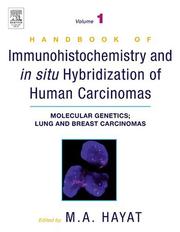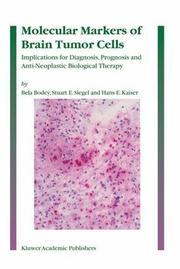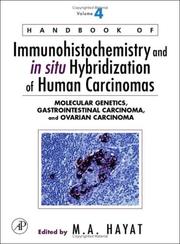| Listing 1 - 10 of 13 | << page >> |
Sort by
|
Book
ISBN: 1616686111 9781616686116 1616682612 9781616682613 Year: 2010 Publisher: Hauppauge, N.Y. : Nova Science Publishers,
Abstract | Keywords | Export | Availability | Bookmark
 Loading...
Loading...Choose an application
- Reference Manager
- EndNote
- RefWorks (Direct export to RefWorks)
Diagnostic immunohistochemistry. --- Diagnostic immunohistology --- Immunodiagnosis --- Immunohistochemistry

ISBN: 1281011681 9786611011680 0080495192 0123339413 9780123339416 Year: 2004 Publisher: Amsterdam ; Boston : Elsevier Academic Press,
Abstract | Keywords | Export | Availability | Bookmark
 Loading...
Loading...Choose an application
- Reference Manager
- EndNote
- RefWorks (Direct export to RefWorks)
The various cell types have traditionally been recognized and classified according to their appearance in the light microscope following the process of fixing, processing, sectioning, and staining tissues that is known as histology. Classical histology has been augmented byimmunohistochemistry (the use of specific antibodies to stain particular molecular species in situ). Immunohistochemistry has allowed the identification of many more cell types than could be visualized by classical histology, particularly in the immune system and among the scattered hormone-secreting cells of the
Molecular genetics. --- Lungs --- Breast --- Immunohistochemistry. --- In situ hybridization. --- Cancer. --- Nucleic acid hybridization --- Immunohistology --- Histochemistry --- Immunochemistry --- Lung cancer --- Genetics --- Molecular biology

ISBN: 1402027818 9786610190782 1280190787 1402028040 Year: 2004 Publisher: Dordrecht ; London : Kluwer Academic Publishers,
Abstract | Keywords | Export | Availability | Bookmark
 Loading...
Loading...Choose an application
- Reference Manager
- EndNote
- RefWorks (Direct export to RefWorks)
Childhood brain tumors are a diverse group of diseases characterized by the abnormal growth of tissue contained within the skull. Other than leukemia and lymphoma, brain tumors are the most common type of neoplasms that occur in children. The leading cause of death from childhood neoplasms among persons up to 19 years is brain tumors. As such, this book is a review of the most recent molecular biological research concerning brain tumors with references and comparisons to a variety of neoplastic disorders. The book then uses this information to foreshadow the direction that future anti-neoplastic therapies will take. Because of the wide spectrum of the objectives of the book, any individual involved in cancer research will greatly benefit from the work. Histopathologists, neuropathologists, clinical and research oncologists, and medical students will find this book to be an invaluable resource as a reference guide. Patients and their families will also find the book useful as it offers a comprehensive update on new, non-classical therapeutic modality options and contains a detailed description and analysis of brain tumors. Such an endeavor has yet to be undertaken by any other book and may prove to be the most comprehensive book on brain tumors thus far.
Brain --- Tumors in children. --- Molecular biology --- Immunohistochemistry. --- Tumors. --- Research. --- Immunohistology --- Pediatric oncology --- Medicine. --- Cancer research. --- Oncology. --- Neurobiology. --- Biomedicine. --- Cancer Research. --- Histochemistry --- Immunochemistry --- Children --- Diseases --- Oncology . --- Neurosciences --- Tumors --- Cancer research

ISBN: 128064138X 9786610641383 0080457878 0123694027 9780123694027 Year: 2006 Publisher: Boston : Elsevier Academic Press,
Abstract | Keywords | Export | Availability | Bookmark
 Loading...
Loading...Choose an application
- Reference Manager
- EndNote
- RefWorks (Direct export to RefWorks)
Classical histology has been augmented by immunohistochemistry (the use of specific antibodies to stain particular molecular species in situ). Immunohistochemistry has allowed the identification of many more cell types than could be visualized by classical histology, particularly in the immune system and among the scattered hormone-secreting cells of the endocrine system. This book discusses all aspects of immunohistochemistry and in situ hybridization technologies and the important role they play in reaching a cancer diagnosis. It provides step-by-step instructions on the methods
Cancer --- Immunohistochemistry. --- In situ hybridization. --- Fluorescence in situ hybridization. --- Immunodiagnosis. --- FISH (Fluorescence in situ hybridization) --- Fluorescent in situ hybridization --- Fluorescence microscopy --- In situ hybridization --- Nucleic acid hybridization --- Immunohistology --- Histochemistry --- Immunochemistry --- Diagnosis --- Immunological aspects
Book
ISBN: 1616689323 9781616689322 1608762831 9781608762835 Year: 2010 Publisher: New York : Nova Science,
Abstract | Keywords | Export | Availability | Bookmark
 Loading...
Loading...Choose an application
- Reference Manager
- EndNote
- RefWorks (Direct export to RefWorks)
Histochemistry. --- Immunohistochemistry. --- Norepinephrine. --- Immunohistology --- Histochemistry --- Immunochemistry --- Biochemistry --- Histology --- Arterenol --- Levarterenol --- Levonor --- Levonorepinephrine --- Levophed --- Levophed bitartrate --- Noradrenalin --- Noradrenaline --- Noradrenaline bitartrate --- Norepinephrine bitartrate --- Norepinephrine hydrochloride --- Sympathin --- Catecholamines --- Ethanolamines --- Neurotransmitters --- Sympathomimetic agents --- Noradrenergic mechanisms --- Noradrenaline.
Periodical
Abstract | Keywords | Export | Availability | Bookmark
 Loading...
Loading...Choose an application
- Reference Manager
- EndNote
- RefWorks (Direct export to RefWorks)
Devoted to research in immunological science and medicine from basic research to clinical research.
innate immunity and inflammation --- structural immunology --- autoimmunity and immunoregulation --- neuroimmunology --- immunopathology and immunohistology --- clinical/translational immunology --- Immunology --- Immunogenetics --- Periodicals --- Clinical/translational immunology --- reproductive immunology --- Genetics --- Immunity --- Serology --- Immunological aspects --- Genetic aspects --- Immunology. --- Immunobiology --- Life sciences
Book
ISBN: 9781493915781 1493915770 9781493915774 1493915789 Year: 2015 Publisher: New York, NY : Springer New York : Imprint: Springer,
Abstract | Keywords | Export | Availability | Bookmark
 Loading...
Loading...Choose an application
- Reference Manager
- EndNote
- RefWorks (Direct export to RefWorks)
In a conceptually current, quick-reference, Question & Answer format, the second edition of Handbook of Practical Immunohistochemistry: Frequently Asked Questions continues to provide a comprehensive and yet concise state-of-the-art overview of the major issues specific to the field of immunohistochemistry. With links to the authors Immunohistochemical Laboratory website, this volume creates a current and up-to-date information system on immunohistochemistry. This includes access to tissue microarrays (TMA) of over 10,000 tumors and normal tissue to validate common diagnostic panels and provide the best reproducible data for diagnostic purposes. Fully revised and updated from the first edition, the new features of the second edition include over 200 additional questions or revised questions with an IHC panel to answer each question; over 250 new color photos and illustrations; over 20 new useful biomarkers; hundreds of new references; several new chapters to cover phosphoproteins, rabbit monoclonal antibodies, multiplex IHC stains, overview of predictive biomarkers, and integration of IHC into molecular pathology; many new coauthors who are international experts in a related field; many updated IHC panels using Geisinger IHC data collected from over 10,000 tumors and normal tissues; and updated appendices containing detailed antibody information for both manual and automated staining procedures. Comprehensive yet practical and concise, the Handbook of Practical Immunohistochemistry: Frequently Asked Questions, Second Edition will be of great value for surgical pathologists, pathology residents and fellows, cytopathologists, and cytotechnologists.
Medicine & Public Health. --- Pathology. --- Medicine. --- Médecine --- Pathologie --- Immunohistochemistry -- Handbooks, manuals, etc. --- Medicine --- Pathology --- Investigative Techniques --- Immunologic Tests --- Laboratory Techniques and Procedures --- Analytical, Diagnostic and Therapeutic Techniques and Equipment --- Diagnosis --- Immunohistochemistry --- Methods --- Health & Biological Sciences --- Immunohistology --- Histochemistry --- Immunochemistry --- Disease (Pathology) --- Medical sciences --- Diseases --- Medicine, Preventive
Book
ISBN: 3319305883 3319305905 Year: 2016 Publisher: Cham : Springer International Publishing : Imprint: Springer,
Abstract | Keywords | Export | Availability | Bookmark
 Loading...
Loading...Choose an application
- Reference Manager
- EndNote
- RefWorks (Direct export to RefWorks)
This book provides a comprehensive, state-of-the-art account of the role of immunohistochemistry in the diagnosis of skin tumors, which is crucial given that overlapping histologic features and unusual morphologic changes can lead to considerable diagnostic uncertainty. The book reviews in detail the sensitivity and specificity of commonly available antibodies and their pattern of immunostaining. Readers will learn when to order antibodies and how to interpret findings. In addition, prognostic markers are evaluated and emphasis placed on the pitfalls commonly encountered when evaluating these neoplasms. The informative text is complemented by a wealth of superb images. Helpful histograms and algorithms are included, and clear guidance is provided on the application and interpretation of less commonly used antibodies and immunostains. With the emergence of many immunomarkers, immunohistochemistry has become a vital ancillary diagnostic tool in dermatopathology and an essential adjunct for the correct identification of skin neoplasms. Indeed, immunohistochemistry has replaced simple morphologic evaluation as the definitive diagnostic method for various tumor types. The complexity of some skin neoplasms makes it imperative that the role of immunohistochemistry in subtyping these conditions is clearly understood. Against this background, Applied Immunohistochemistry in the Evaluation of Skin Neoplasms will serve as an extremely valuable resource for practicing dermatopathologists and pathologists.
Medicine. --- Laboratory medicine. --- Dermatology. --- Pathology. --- Medicine & Public Health. --- Laboratory Medicine. --- Skin --- Immunohistochemistry. --- Tumors --- Diagnosis. --- Immunohistology --- Cutis --- Integument (Skin) --- Beauty, Personal --- Body covering (Anatomy) --- Histochemistry --- Immunochemistry --- Medical laboratories. --- Diagnosis, Laboratory --- Health facilities --- Laboratories --- Medicine --- Disease (Pathology) --- Medical sciences --- Diseases --- Medicine, Preventive --- Clinical medicine --- Clinical pathology --- Diagnostic laboratory tests --- Laboratory diagnosis --- Laboratory medicine --- Medical laboratory diagnosis --- Diagnosis --- Pathology
Book
ISBN: 144198061X 1441980628 1299407943 Year: 2011 Publisher: New York, NY : Springer New York : Imprint: Springer,
Abstract | Keywords | Export | Availability | Bookmark
 Loading...
Loading...Choose an application
- Reference Manager
- EndNote
- RefWorks (Direct export to RefWorks)
In a conceptually current, quick-reference, Question & Answer format, the Handbook of Practical Immunohistochemistry: Frequently Asked Questions provides standardization of the immunostaining process for each antibody and for each staining panel. With links to the authors Immunohistochemical Laboratory website, this volume creates a current and up-to-date information system on immunohistochemistry. This includes access to tissue microarrays (TMA) of over 5,000 tumors to validate common diagnostic panels and provide the best reproducible data for diagnostic purposes. Chapters are presented in a unique Question and Answer format. One table/IHC panel is provided to address each question. A concise explanatory note follows each table/panel to avoid diagnostic pitfalls. Website links are provided throughout to update the massive information in this field, providing the most current knowledge and the potential for live expert consultation. All chapters are written by nationally/internationally recognized experts in the related area ensuring authority and excellence. Comprehensive yet practical and concise, the Handbook of Practical Immunohistochemistry: Frequently Asked Questions, will be of great value for surgical pathologists, pathology residents and fellows, cytopathologists, and cytotechnologists.
Antigens. --- Histochemistry. --- Immunohistochemistry. --- Neoplasms -- diagnosis. --- Noradrenaline. --- Immunohistochemistry --- Histocytochemistry --- Immunochemistry --- Immunologic Tests --- Biochemistry --- Laboratory Techniques and Procedures --- Cytological Techniques --- Histological Techniques --- Histology --- Immunologic Techniques --- Investigative Techniques --- Anatomy --- Diagnosis --- Chemistry --- Clinical Laboratory Techniques --- Biological Science Disciplines --- Natural Science Disciplines --- Analytical, Diagnostic and Therapeutic Techniques and Equipment --- Disciplines and Occupations --- Biology --- Medicine --- Health & Biological Sciences --- Pathology --- Microbiology & Immunology --- Immunohistology --- Medicine. --- Pathology. --- Medicine & Public Health. --- Histochemistry --- Disease (Pathology) --- Medical sciences --- Diseases --- Medicine, Preventive
Book
ISBN: 3319308912 3319308939 Year: 2016 Publisher: Cham : Springer International Publishing : Imprint: Springer,
Abstract | Keywords | Export | Availability | Bookmark
 Loading...
Loading...Choose an application
- Reference Manager
- EndNote
- RefWorks (Direct export to RefWorks)
Aimed at both beginners and experienced researchers unfamiliar with the technique, this book provides a concise and easy-to-understand guide to using immunohistochemistry. It identifies the proper place and purpose of each component of immunohistochemistry, emphasizes the components that are of critical importance, and explains the logistics of experimental approaches. Understanding the principles of immunohistochemistry allows for the identification and localization of protein targets and is of crucial use in the following experiments: · producing transgenic animals · studying the effects of drug treatments · electrophysiological studies · animal surgery · isolating and differentiating stem cells · super-resolution microscopy Immunohistochemistry for the Non-Expert is aimed at a wide audience, including molecular biologists, pharmacologists, immunologists, chemists, cell biologists, physiologists, and researchers involved with animal anatomy studies.
Biophysics --- Biology --- Health & Biological Sciences --- Immunohistochemistry. --- Antigens. --- Immunoglobulins. --- Antibodies --- Immune globulins --- Immune serum globulin --- Immunohistology --- Immunity --- Immunoglobulins --- Histochemistry --- Immunochemistry --- Blood proteins --- Globulins --- Plasma cells --- Antibody diversity --- Antigens --- Bacterial immunoglobulin-binding proteins --- Medicine. --- Monoclonal antibodies. --- Neurochemistry. --- Molecular Medicine. --- Antibodies. --- Biochemistry --- Neurosciences --- Antibodies, Monoclonal --- Monoclonal immunoglobulins --- Molecular cloning --- Clinical sciences --- Medical profession --- Human biology --- Life sciences --- Medical sciences --- Pathology --- Physicians --- Health Workforce --- Molecular biology. --- Molecular biochemistry --- Molecular biophysics --- Biomolecules --- Systems biology
| Listing 1 - 10 of 13 | << page >> |
Sort by
|

 Search
Search Feedback
Feedback About UniCat
About UniCat  Help
Help News
News